Decision-Making Styles Analysis Report, MGT602, Trimester 1, 2019
VerifiedAdded on 2022/11/28
|9
|1589
|184
Report
AI Summary
This reflective report analyzes the author's decision-making style, focusing on a major decision involving workforce replacement. The report details the author's decision-making preferences, personality style, and strengths, highlighting an analytical approach emphasizing evidence-based reasoning. It includes reflections on feedback from classmates and the use of secondary data sources and decision-making tools, such as decision trees. The author evaluates the significance of their decisions in terms of productivity and managerial activities, and presents visual interpretations of data trends and patterns. The report concludes by emphasizing the application of prescriptive data analytics for making informed decisions in human resources and operational contexts. The assignment fulfills the requirements of MGT602 Business Decision Analytics, assessing the author's ability to reflect on their decision-making preferences and tools, and to compare and contrast their style with others.
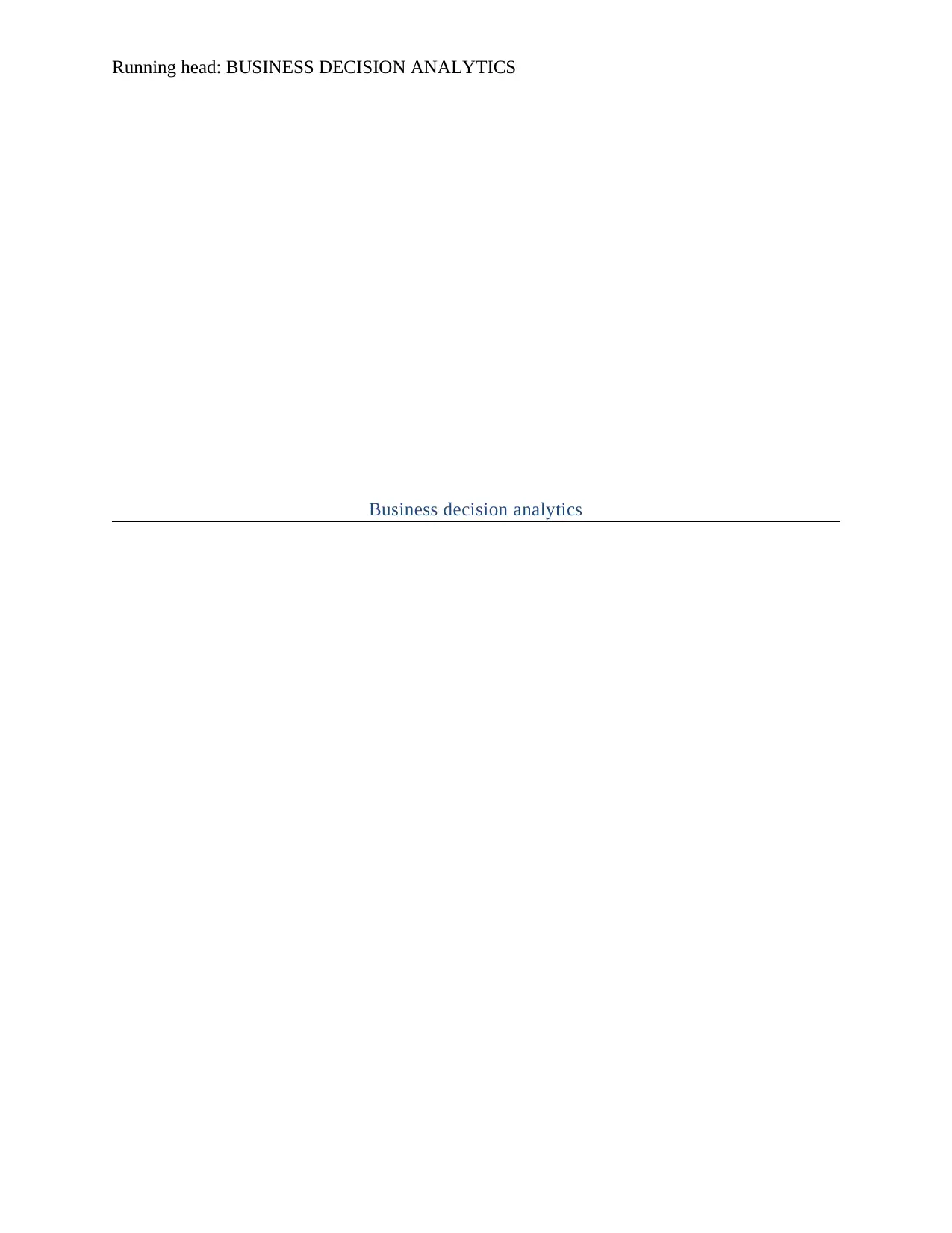
Running head: BUSINESS DECISION ANALYTICS
Business decision analytics
Business decision analytics
Paraphrase This Document
Need a fresh take? Get an instant paraphrase of this document with our AI Paraphraser
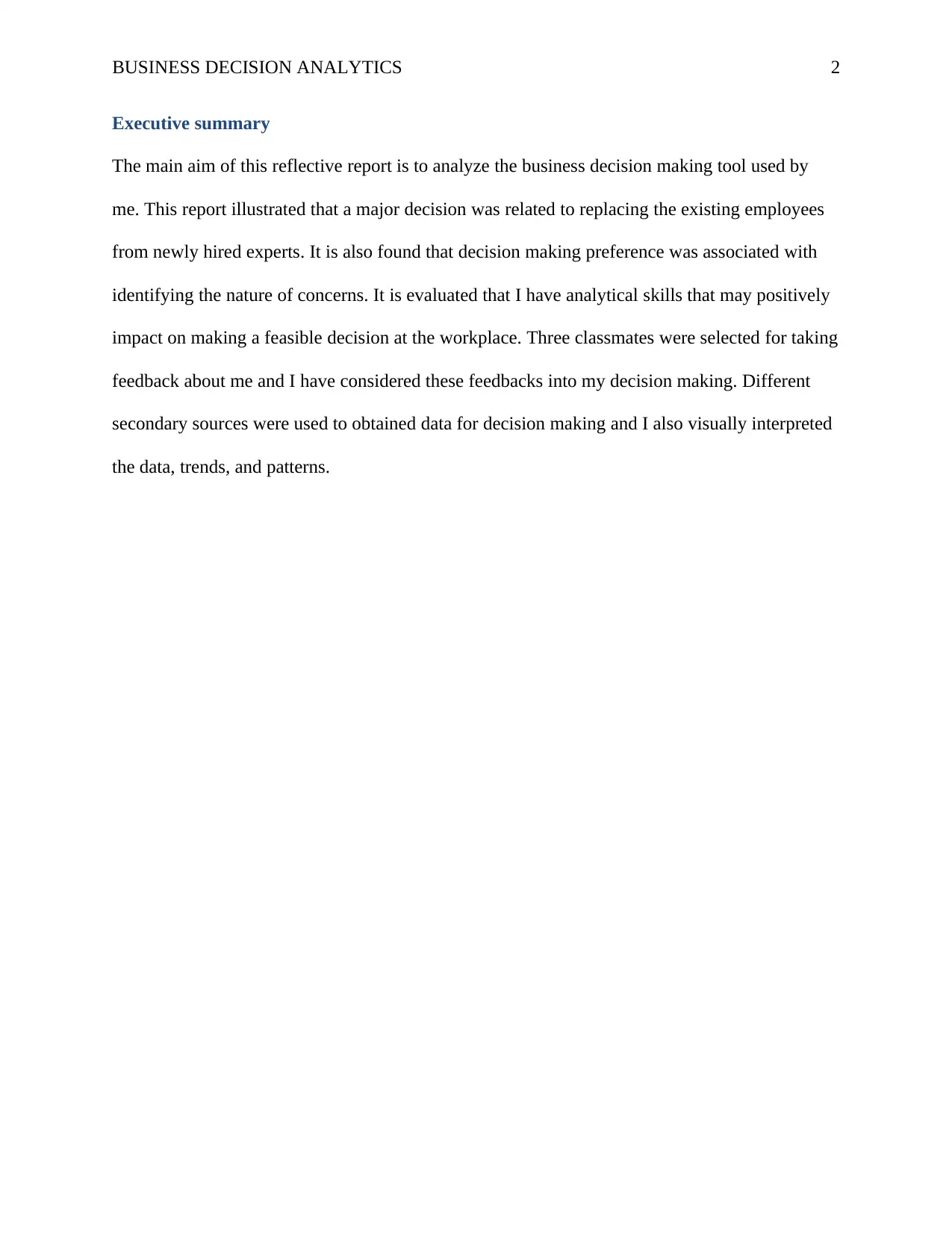
BUSINESS DECISION ANALYTICS 2
Executive summary
The main aim of this reflective report is to analyze the business decision making tool used by
me. This report illustrated that a major decision was related to replacing the existing employees
from newly hired experts. It is also found that decision making preference was associated with
identifying the nature of concerns. It is evaluated that I have analytical skills that may positively
impact on making a feasible decision at the workplace. Three classmates were selected for taking
feedback about me and I have considered these feedbacks into my decision making. Different
secondary sources were used to obtained data for decision making and I also visually interpreted
the data, trends, and patterns.
Executive summary
The main aim of this reflective report is to analyze the business decision making tool used by
me. This report illustrated that a major decision was related to replacing the existing employees
from newly hired experts. It is also found that decision making preference was associated with
identifying the nature of concerns. It is evaluated that I have analytical skills that may positively
impact on making a feasible decision at the workplace. Three classmates were selected for taking
feedback about me and I have considered these feedbacks into my decision making. Different
secondary sources were used to obtained data for decision making and I also visually interpreted
the data, trends, and patterns.
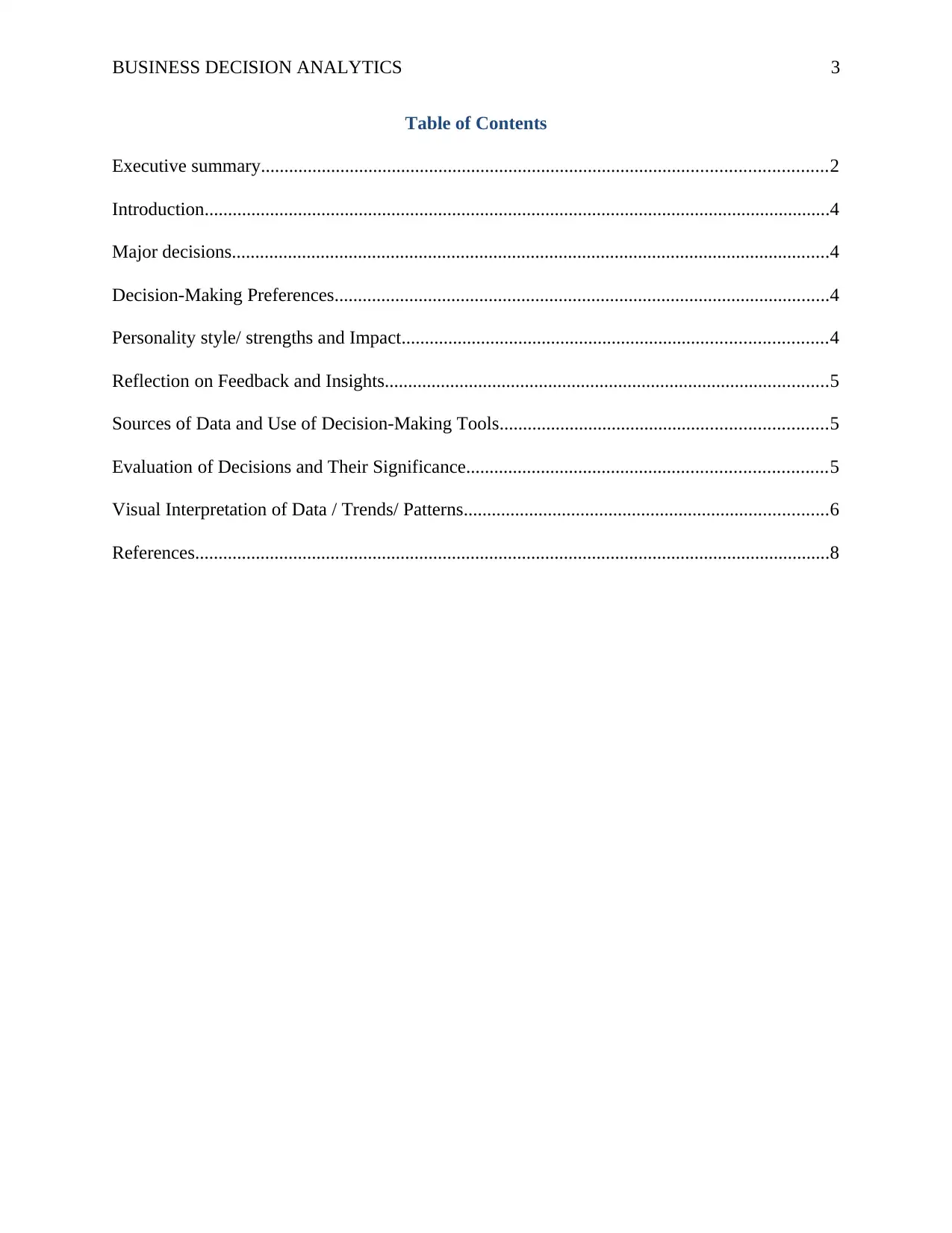
BUSINESS DECISION ANALYTICS 3
Table of Contents
Executive summary.........................................................................................................................2
Introduction......................................................................................................................................4
Major decisions................................................................................................................................4
Decision-Making Preferences..........................................................................................................4
Personality style/ strengths and Impact...........................................................................................4
Reflection on Feedback and Insights...............................................................................................5
Sources of Data and Use of Decision-Making Tools......................................................................5
Evaluation of Decisions and Their Significance.............................................................................5
Visual Interpretation of Data / Trends/ Patterns..............................................................................6
References........................................................................................................................................8
Table of Contents
Executive summary.........................................................................................................................2
Introduction......................................................................................................................................4
Major decisions................................................................................................................................4
Decision-Making Preferences..........................................................................................................4
Personality style/ strengths and Impact...........................................................................................4
Reflection on Feedback and Insights...............................................................................................5
Sources of Data and Use of Decision-Making Tools......................................................................5
Evaluation of Decisions and Their Significance.............................................................................5
Visual Interpretation of Data / Trends/ Patterns..............................................................................6
References........................................................................................................................................8
⊘ This is a preview!⊘
Do you want full access?
Subscribe today to unlock all pages.

Trusted by 1+ million students worldwide
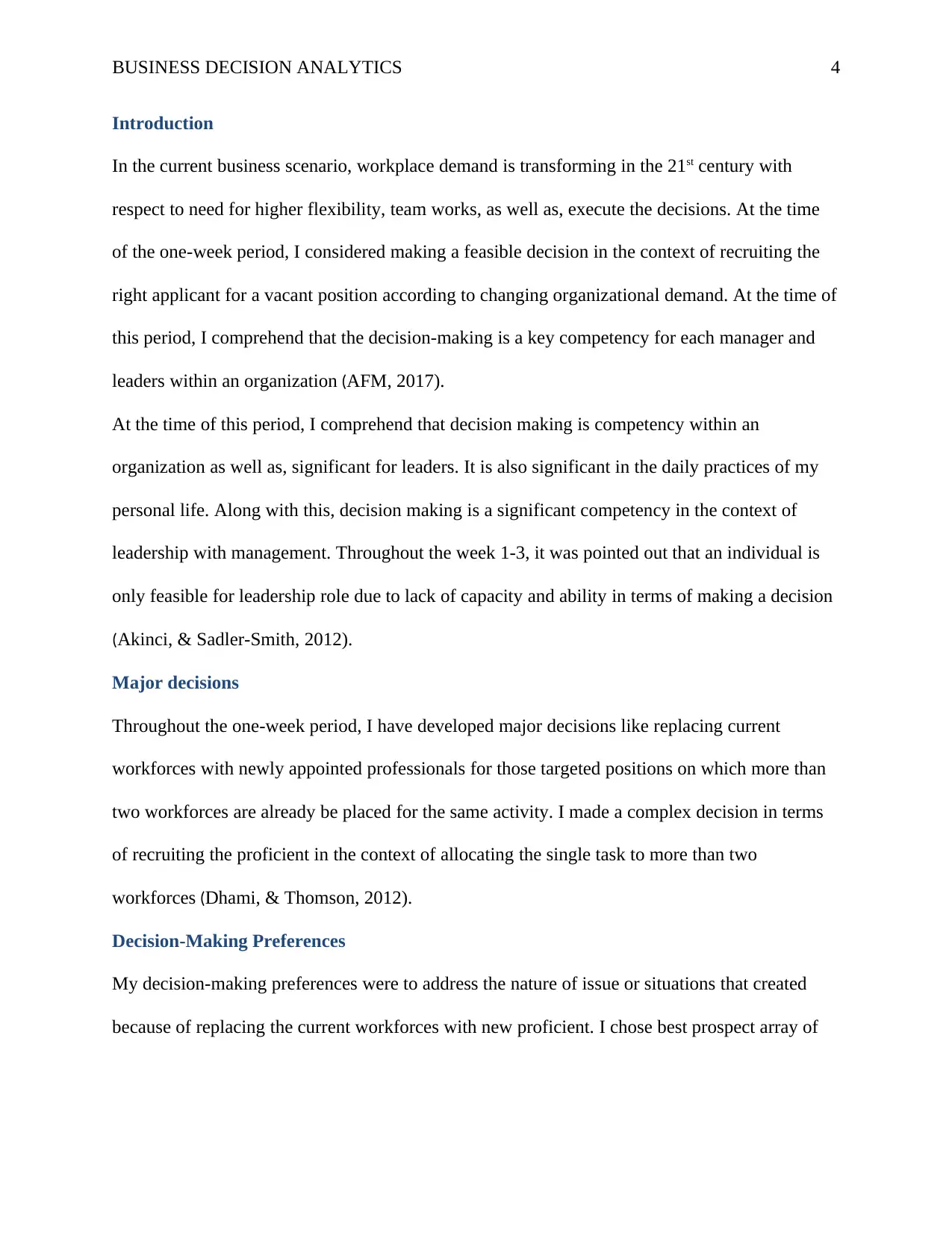
BUSINESS DECISION ANALYTICS 4
Introduction
In the current business scenario, workplace demand is transforming in the 21st century with
respect to need for higher flexibility, team works, as well as, execute the decisions. At the time
of the one-week period, I considered making a feasible decision in the context of recruiting the
right applicant for a vacant position according to changing organizational demand. At the time of
this period, I comprehend that the decision-making is a key competency for each manager and
leaders within an organization (AFM, 2017).
At the time of this period, I comprehend that decision making is competency within an
organization as well as, significant for leaders. It is also significant in the daily practices of my
personal life. Along with this, decision making is a significant competency in the context of
leadership with management. Throughout the week 1-3, it was pointed out that an individual is
only feasible for leadership role due to lack of capacity and ability in terms of making a decision
(Akinci, & Sadler-Smith, 2012).
Major decisions
Throughout the one-week period, I have developed major decisions like replacing current
workforces with newly appointed professionals for those targeted positions on which more than
two workforces are already be placed for the same activity. I made a complex decision in terms
of recruiting the proficient in the context of allocating the single task to more than two
workforces (Dhami, & Thomson, 2012).
Decision-Making Preferences
My decision-making preferences were to address the nature of issue or situations that created
because of replacing the current workforces with new proficient. I chose best prospect array of
Introduction
In the current business scenario, workplace demand is transforming in the 21st century with
respect to need for higher flexibility, team works, as well as, execute the decisions. At the time
of the one-week period, I considered making a feasible decision in the context of recruiting the
right applicant for a vacant position according to changing organizational demand. At the time of
this period, I comprehend that the decision-making is a key competency for each manager and
leaders within an organization (AFM, 2017).
At the time of this period, I comprehend that decision making is competency within an
organization as well as, significant for leaders. It is also significant in the daily practices of my
personal life. Along with this, decision making is a significant competency in the context of
leadership with management. Throughout the week 1-3, it was pointed out that an individual is
only feasible for leadership role due to lack of capacity and ability in terms of making a decision
(Akinci, & Sadler-Smith, 2012).
Major decisions
Throughout the one-week period, I have developed major decisions like replacing current
workforces with newly appointed professionals for those targeted positions on which more than
two workforces are already be placed for the same activity. I made a complex decision in terms
of recruiting the proficient in the context of allocating the single task to more than two
workforces (Dhami, & Thomson, 2012).
Decision-Making Preferences
My decision-making preferences were to address the nature of issue or situations that created
because of replacing the current workforces with new proficient. I chose best prospect array of
Paraphrase This Document
Need a fresh take? Get an instant paraphrase of this document with our AI Paraphraser
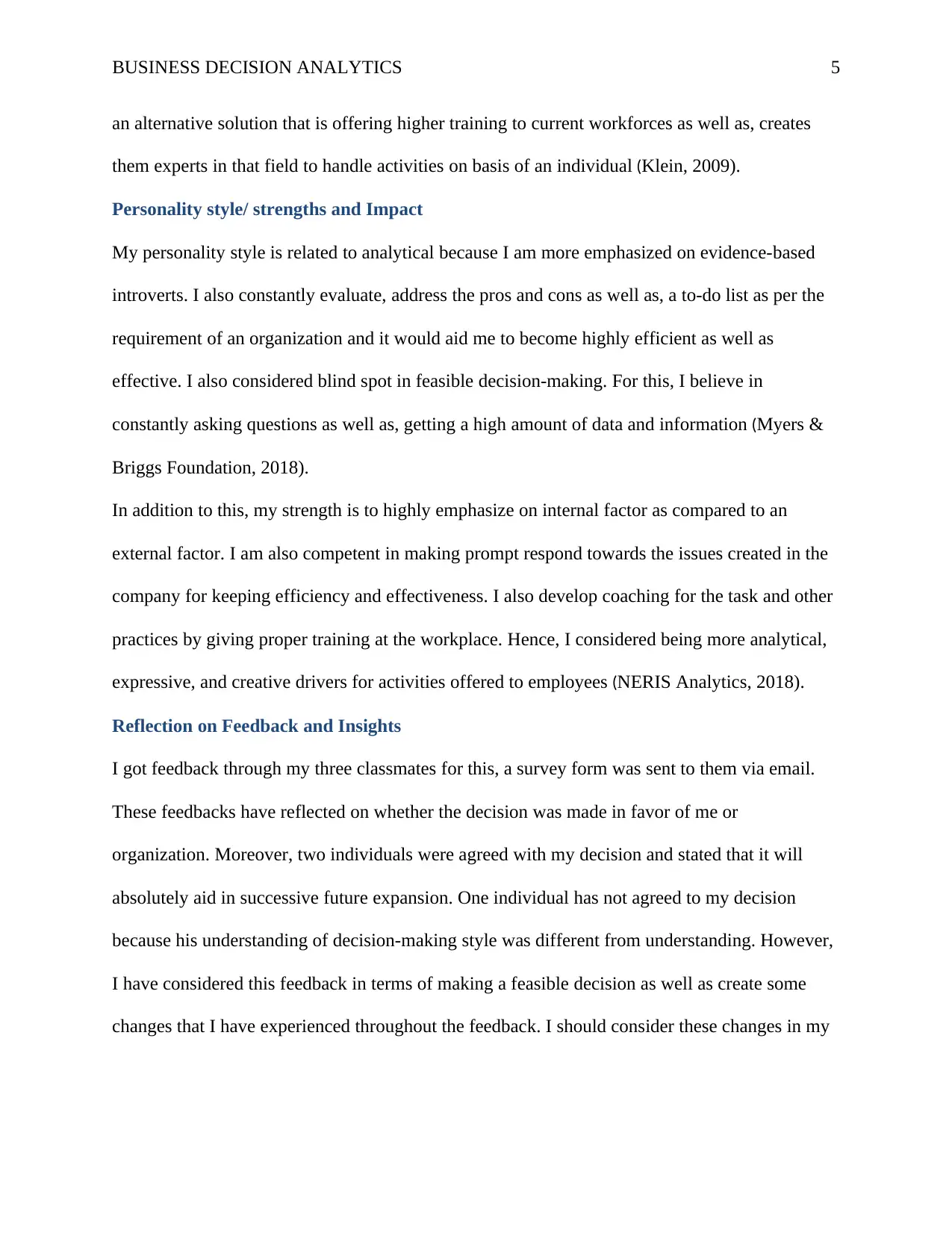
BUSINESS DECISION ANALYTICS 5
an alternative solution that is offering higher training to current workforces as well as, creates
them experts in that field to handle activities on basis of an individual (Klein, 2009).
Personality style/ strengths and Impact
My personality style is related to analytical because I am more emphasized on evidence-based
introverts. I also constantly evaluate, address the pros and cons as well as, a to-do list as per the
requirement of an organization and it would aid me to become highly efficient as well as
effective. I also considered blind spot in feasible decision-making. For this, I believe in
constantly asking questions as well as, getting a high amount of data and information (Myers &
Briggs Foundation, 2018).
In addition to this, my strength is to highly emphasize on internal factor as compared to an
external factor. I am also competent in making prompt respond towards the issues created in the
company for keeping efficiency and effectiveness. I also develop coaching for the task and other
practices by giving proper training at the workplace. Hence, I considered being more analytical,
expressive, and creative drivers for activities offered to employees (NERIS Analytics, 2018).
Reflection on Feedback and Insights
I got feedback through my three classmates for this, a survey form was sent to them via email.
These feedbacks have reflected on whether the decision was made in favor of me or
organization. Moreover, two individuals were agreed with my decision and stated that it will
absolutely aid in successive future expansion. One individual has not agreed to my decision
because his understanding of decision-making style was different from understanding. However,
I have considered this feedback in terms of making a feasible decision as well as create some
changes that I have experienced throughout the feedback. I should consider these changes in my
an alternative solution that is offering higher training to current workforces as well as, creates
them experts in that field to handle activities on basis of an individual (Klein, 2009).
Personality style/ strengths and Impact
My personality style is related to analytical because I am more emphasized on evidence-based
introverts. I also constantly evaluate, address the pros and cons as well as, a to-do list as per the
requirement of an organization and it would aid me to become highly efficient as well as
effective. I also considered blind spot in feasible decision-making. For this, I believe in
constantly asking questions as well as, getting a high amount of data and information (Myers &
Briggs Foundation, 2018).
In addition to this, my strength is to highly emphasize on internal factor as compared to an
external factor. I am also competent in making prompt respond towards the issues created in the
company for keeping efficiency and effectiveness. I also develop coaching for the task and other
practices by giving proper training at the workplace. Hence, I considered being more analytical,
expressive, and creative drivers for activities offered to employees (NERIS Analytics, 2018).
Reflection on Feedback and Insights
I got feedback through my three classmates for this, a survey form was sent to them via email.
These feedbacks have reflected on whether the decision was made in favor of me or
organization. Moreover, two individuals were agreed with my decision and stated that it will
absolutely aid in successive future expansion. One individual has not agreed to my decision
because his understanding of decision-making style was different from understanding. However,
I have considered this feedback in terms of making a feasible decision as well as create some
changes that I have experienced throughout the feedback. I should consider these changes in my
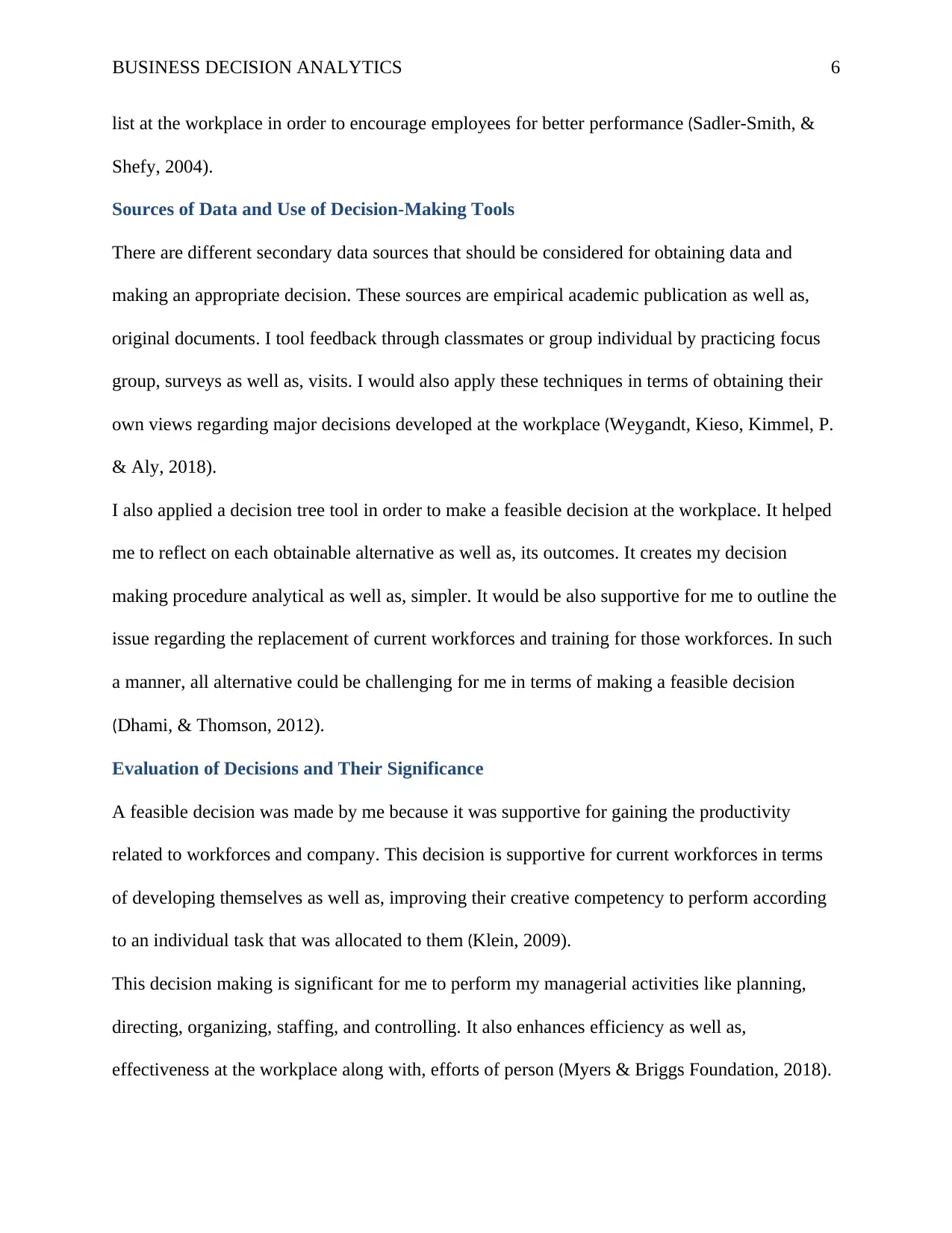
BUSINESS DECISION ANALYTICS 6
list at the workplace in order to encourage employees for better performance (Sadler-Smith, &
Shefy, 2004).
Sources of Data and Use of Decision-Making Tools
There are different secondary data sources that should be considered for obtaining data and
making an appropriate decision. These sources are empirical academic publication as well as,
original documents. I tool feedback through classmates or group individual by practicing focus
group, surveys as well as, visits. I would also apply these techniques in terms of obtaining their
own views regarding major decisions developed at the workplace (Weygandt, Kieso, Kimmel, P.
& Aly, 2018).
I also applied a decision tree tool in order to make a feasible decision at the workplace. It helped
me to reflect on each obtainable alternative as well as, its outcomes. It creates my decision
making procedure analytical as well as, simpler. It would be also supportive for me to outline the
issue regarding the replacement of current workforces and training for those workforces. In such
a manner, all alternative could be challenging for me in terms of making a feasible decision
(Dhami, & Thomson, 2012).
Evaluation of Decisions and Their Significance
A feasible decision was made by me because it was supportive for gaining the productivity
related to workforces and company. This decision is supportive for current workforces in terms
of developing themselves as well as, improving their creative competency to perform according
to an individual task that was allocated to them (Klein, 2009).
This decision making is significant for me to perform my managerial activities like planning,
directing, organizing, staffing, and controlling. It also enhances efficiency as well as,
effectiveness at the workplace along with, efforts of person (Myers & Briggs Foundation, 2018).
list at the workplace in order to encourage employees for better performance (Sadler-Smith, &
Shefy, 2004).
Sources of Data and Use of Decision-Making Tools
There are different secondary data sources that should be considered for obtaining data and
making an appropriate decision. These sources are empirical academic publication as well as,
original documents. I tool feedback through classmates or group individual by practicing focus
group, surveys as well as, visits. I would also apply these techniques in terms of obtaining their
own views regarding major decisions developed at the workplace (Weygandt, Kieso, Kimmel, P.
& Aly, 2018).
I also applied a decision tree tool in order to make a feasible decision at the workplace. It helped
me to reflect on each obtainable alternative as well as, its outcomes. It creates my decision
making procedure analytical as well as, simpler. It would be also supportive for me to outline the
issue regarding the replacement of current workforces and training for those workforces. In such
a manner, all alternative could be challenging for me in terms of making a feasible decision
(Dhami, & Thomson, 2012).
Evaluation of Decisions and Their Significance
A feasible decision was made by me because it was supportive for gaining the productivity
related to workforces and company. This decision is supportive for current workforces in terms
of developing themselves as well as, improving their creative competency to perform according
to an individual task that was allocated to them (Klein, 2009).
This decision making is significant for me to perform my managerial activities like planning,
directing, organizing, staffing, and controlling. It also enhances efficiency as well as,
effectiveness at the workplace along with, efforts of person (Myers & Briggs Foundation, 2018).
⊘ This is a preview!⊘
Do you want full access?
Subscribe today to unlock all pages.

Trusted by 1+ million students worldwide
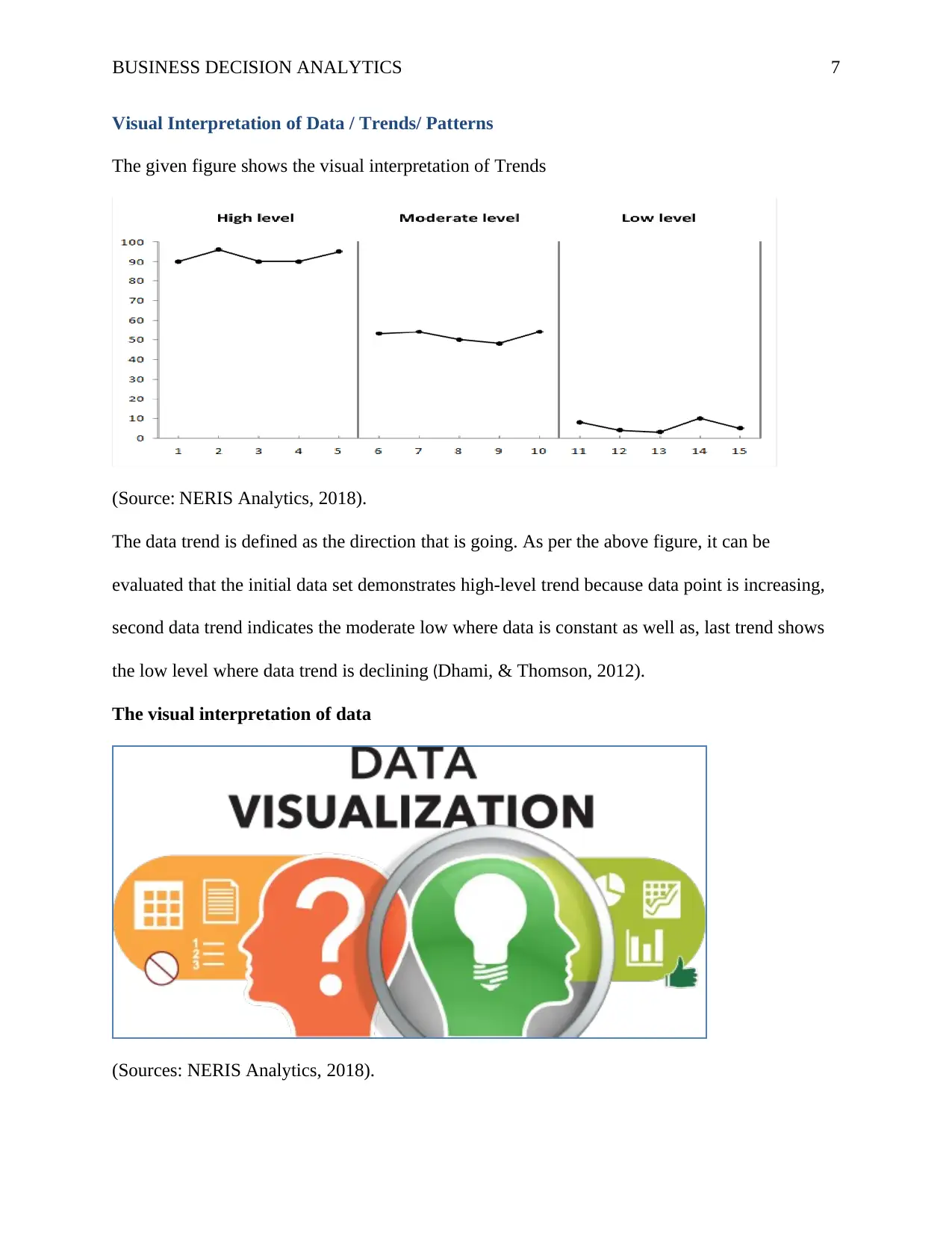
BUSINESS DECISION ANALYTICS 7
Visual Interpretation of Data / Trends/ Patterns
The given figure shows the visual interpretation of Trends
(Source: NERIS Analytics, 2018).
The data trend is defined as the direction that is going. As per the above figure, it can be
evaluated that the initial data set demonstrates high-level trend because data point is increasing,
second data trend indicates the moderate low where data is constant as well as, last trend shows
the low level where data trend is declining (Dhami, & Thomson, 2012).
The visual interpretation of data
(Sources: NERIS Analytics, 2018).
Visual Interpretation of Data / Trends/ Patterns
The given figure shows the visual interpretation of Trends
(Source: NERIS Analytics, 2018).
The data trend is defined as the direction that is going. As per the above figure, it can be
evaluated that the initial data set demonstrates high-level trend because data point is increasing,
second data trend indicates the moderate low where data is constant as well as, last trend shows
the low level where data trend is declining (Dhami, & Thomson, 2012).
The visual interpretation of data
(Sources: NERIS Analytics, 2018).
Paraphrase This Document
Need a fresh take? Get an instant paraphrase of this document with our AI Paraphraser
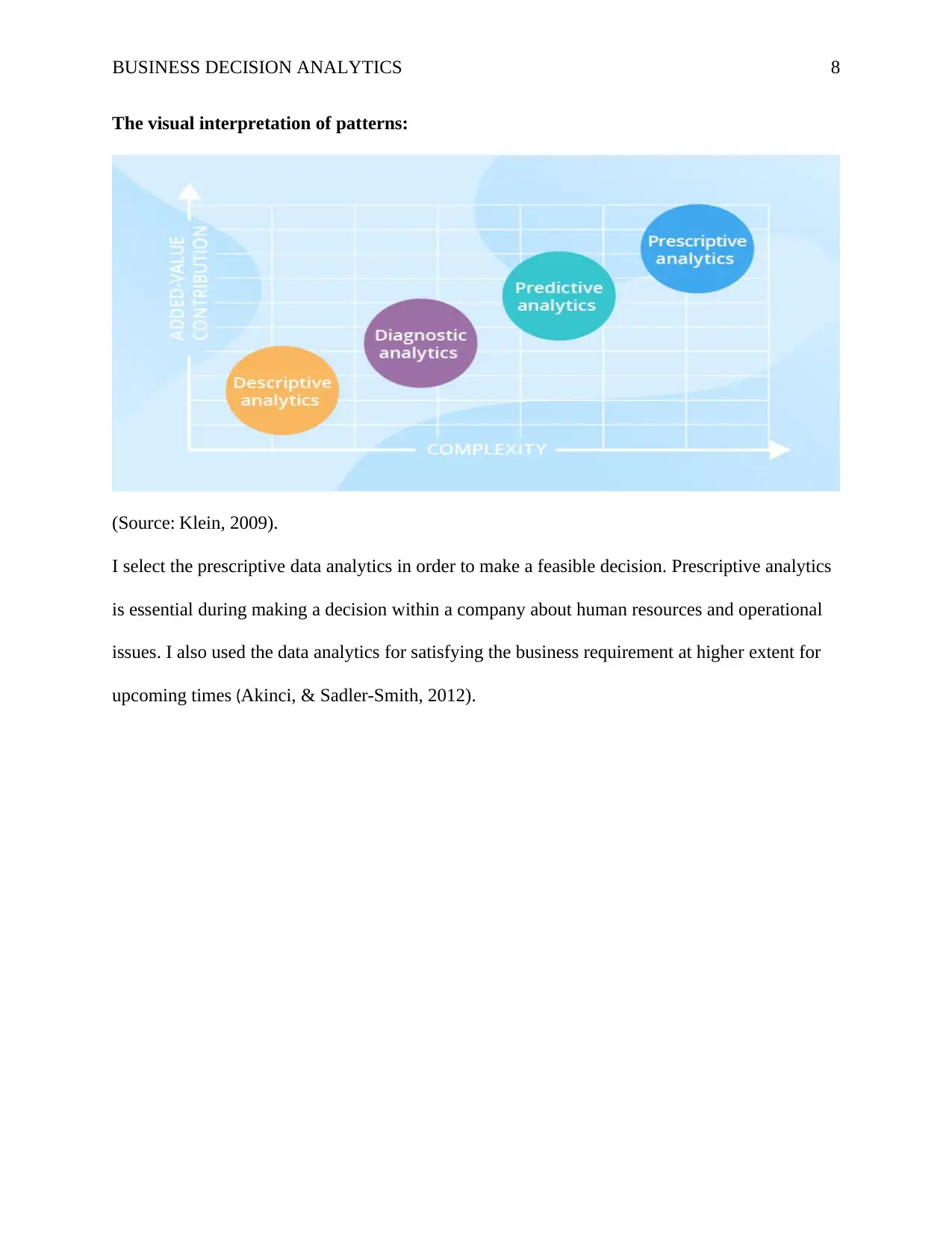
BUSINESS DECISION ANALYTICS 8
The visual interpretation of patterns:
(Source: Klein, 2009).
I select the prescriptive data analytics in order to make a feasible decision. Prescriptive analytics
is essential during making a decision within a company about human resources and operational
issues. I also used the data analytics for satisfying the business requirement at higher extent for
upcoming times (Akinci, & Sadler-Smith, 2012).
The visual interpretation of patterns:
(Source: Klein, 2009).
I select the prescriptive data analytics in order to make a feasible decision. Prescriptive analytics
is essential during making a decision within a company about human resources and operational
issues. I also used the data analytics for satisfying the business requirement at higher extent for
upcoming times (Akinci, & Sadler-Smith, 2012).
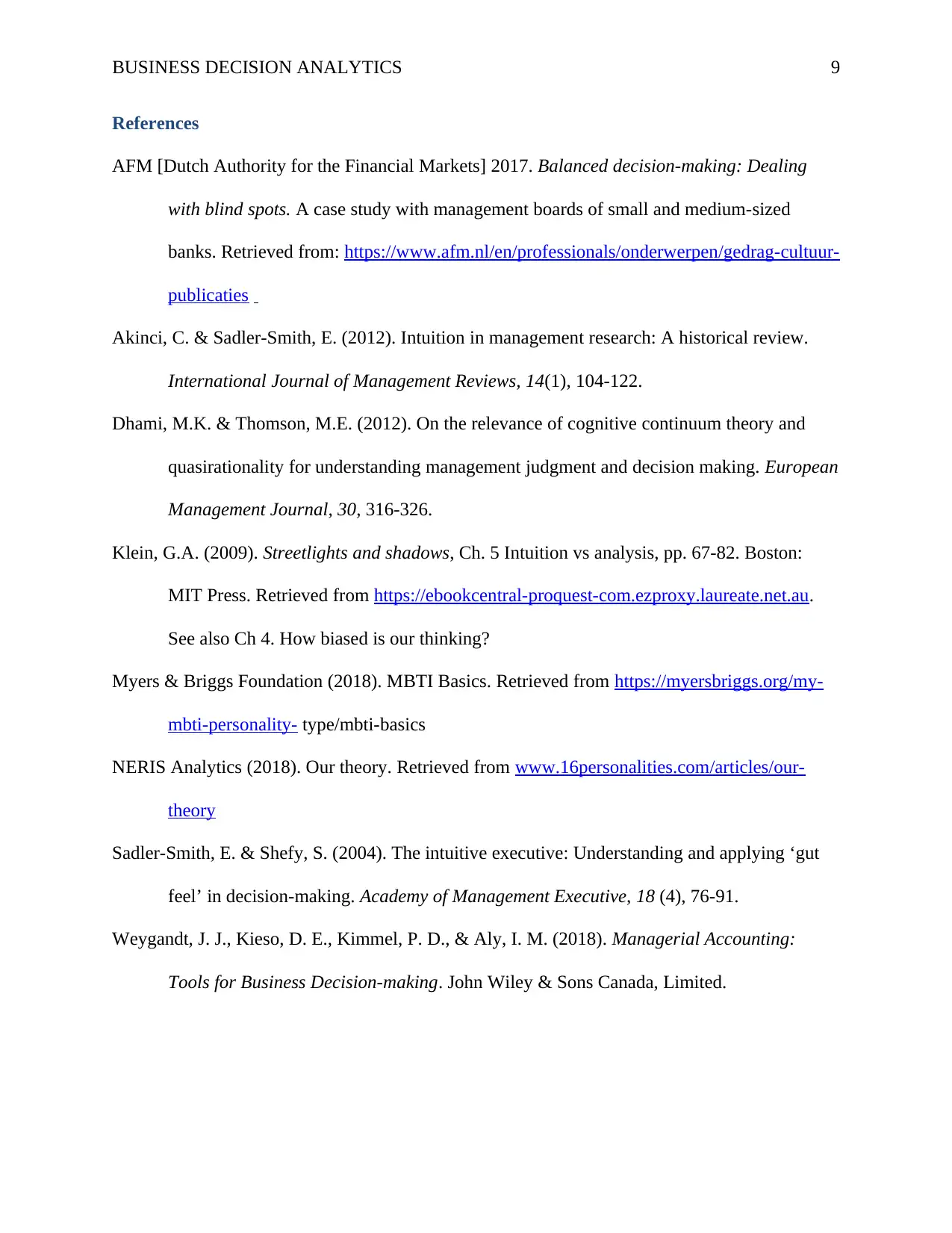
BUSINESS DECISION ANALYTICS 9
References
AFM [Dutch Authority for the Financial Markets] 2017. Balanced decision-making: Dealing
with blind spots. A case study with management boards of small and medium-sized
banks. Retrieved from: https://www.afm.nl/en/professionals/onderwerpen/gedrag-cultuur-
publicaties
Akinci, C. & Sadler-Smith, E. (2012). Intuition in management research: A historical review.
International Journal of Management Reviews, 14(1), 104-122.
Dhami, M.K. & Thomson, M.E. (2012). On the relevance of cognitive continuum theory and
quasirationality for understanding management judgment and decision making. European
Management Journal, 30, 316-326.
Klein, G.A. (2009). Streetlights and shadows, Ch. 5 Intuition vs analysis, pp. 67-82. Boston:
MIT Press. Retrieved from https://ebookcentral-proquest-com.ezproxy.laureate.net.au.
See also Ch 4. How biased is our thinking?
Myers & Briggs Foundation (2018). MBTI Basics. Retrieved from https://myersbriggs.org/my-
mbti-personality- type/mbti-basics
NERIS Analytics (2018). Our theory. Retrieved from www.16personalities.com/articles/our-
theory
Sadler-Smith, E. & Shefy, S. (2004). The intuitive executive: Understanding and applying ‘gut
feel’ in decision-making. Academy of Management Executive, 18 (4), 76-91.
Weygandt, J. J., Kieso, D. E., Kimmel, P. D., & Aly, I. M. (2018). Managerial Accounting:
Tools for Business Decision-making. John Wiley & Sons Canada, Limited.
References
AFM [Dutch Authority for the Financial Markets] 2017. Balanced decision-making: Dealing
with blind spots. A case study with management boards of small and medium-sized
banks. Retrieved from: https://www.afm.nl/en/professionals/onderwerpen/gedrag-cultuur-
publicaties
Akinci, C. & Sadler-Smith, E. (2012). Intuition in management research: A historical review.
International Journal of Management Reviews, 14(1), 104-122.
Dhami, M.K. & Thomson, M.E. (2012). On the relevance of cognitive continuum theory and
quasirationality for understanding management judgment and decision making. European
Management Journal, 30, 316-326.
Klein, G.A. (2009). Streetlights and shadows, Ch. 5 Intuition vs analysis, pp. 67-82. Boston:
MIT Press. Retrieved from https://ebookcentral-proquest-com.ezproxy.laureate.net.au.
See also Ch 4. How biased is our thinking?
Myers & Briggs Foundation (2018). MBTI Basics. Retrieved from https://myersbriggs.org/my-
mbti-personality- type/mbti-basics
NERIS Analytics (2018). Our theory. Retrieved from www.16personalities.com/articles/our-
theory
Sadler-Smith, E. & Shefy, S. (2004). The intuitive executive: Understanding and applying ‘gut
feel’ in decision-making. Academy of Management Executive, 18 (4), 76-91.
Weygandt, J. J., Kieso, D. E., Kimmel, P. D., & Aly, I. M. (2018). Managerial Accounting:
Tools for Business Decision-making. John Wiley & Sons Canada, Limited.
⊘ This is a preview!⊘
Do you want full access?
Subscribe today to unlock all pages.

Trusted by 1+ million students worldwide
1 out of 9
Related Documents
Your All-in-One AI-Powered Toolkit for Academic Success.
+13062052269
info@desklib.com
Available 24*7 on WhatsApp / Email
![[object Object]](/_next/static/media/star-bottom.7253800d.svg)
Unlock your academic potential
Copyright © 2020–2025 A2Z Services. All Rights Reserved. Developed and managed by ZUCOL.





